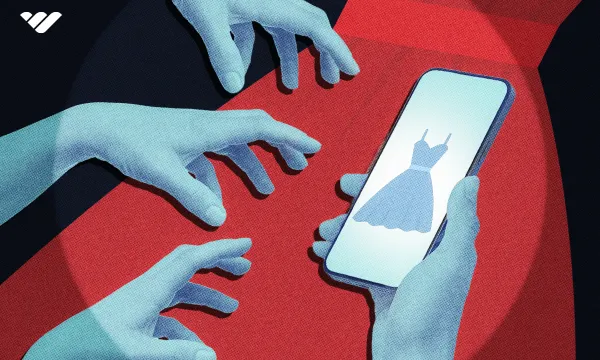The world is continually reshaping alongside technology, and how we shop is no different. Ecommerce continues to transform retail as we know it, capitalizing on the human nature of instant gratification. Like many things on the internet, the growth of online shopping is rapid. In 2025, ecommerce revenue is expected to exceed $7 trillion, with a 25% share of total global sales. But online shopping is being revolutionized from its old days, too.
With the rise of mobile devices and social media, the lines between short-form content and advertising began to blur. Before long, brands sponsored influencers to promote their products, and social media became an exclusive avenue for giveaways, discounts, and freebies. As consumers sought more immersive online shopping experiences and brands started looking for more ways to leverage their online sales, tech giants took note. A new era of online shopping was born in 2016: live shopping.
What is Live Shopping?
Remember flicking on the TV to dedicated shopping channels? TV shopping invited viewers to call a number on-screen to purchase products during the broadcast. Often, you could receive ‘exclusive’ discounts for ordering between certain hours or bundling your order. From jewelry to homewares and even popular cleaning devices (we’re looking at you, Scrub Daddy), live shopping’s humble beginnings really began on our television sets.
Fast-forward to 2016: Chinese ecommerce giant Alibaba introduced Taobao Live during its Singles’ Day sales event. For the first time, the Taobao Live platform merged live streaming with online shopping. Suddenly, shoppers in the marketplace could watch product demonstrations, engage with hosts, and make purchases seamlessly in real time. And get this: in 2020, the first 30 minutes of Alibaba’s Singles’ Day presales campaign generated a jaw-dropping $7.5 billion transaction value.
China remains the pioneer of live shopping (users of live-streaming ecommerce platforms reached 469 million in China by June 2022, accounting for 44.6% of internet users in the country). But the rest of the world is following suit.
As we’ll discuss, some of the biggest global brands are capitalizing on live shopping to boost their sales, brand awareness, and accessibility. Let's take a look at how live shopping works.
How Does Live Shopping Work?
Live shopping is a real-time video broadcast that allows hosts to showcase products and interact with viewers. Shoppers can purchase items instantly without exiting the video stream.
Depending on where the stream is being held, hosts can use links, tags, pinned comments, and other built-in elements to guide viewers through the shopping experience. Platforms integrate shopping carts directly into the broadcast, making the checkout process effortless for customers.
Shoppers can see a product being used, ask questions about it, and even get recommendations from other viewers via the chat. Often, brands will promote their live shopping events to generate hype and have guests register their attendance in advance.
By bridging the gap between physical and digital retail, live shopping allows brands to interact directly with customers like a sales assistant would in-store.
Which Brands Already Use Live Shopping?
As mentioned, many household name brands have been eager to adopt live shopping, with remarkable results.
Let’s look at four commerce giants and their strategies toward live shopping events:
Walmart
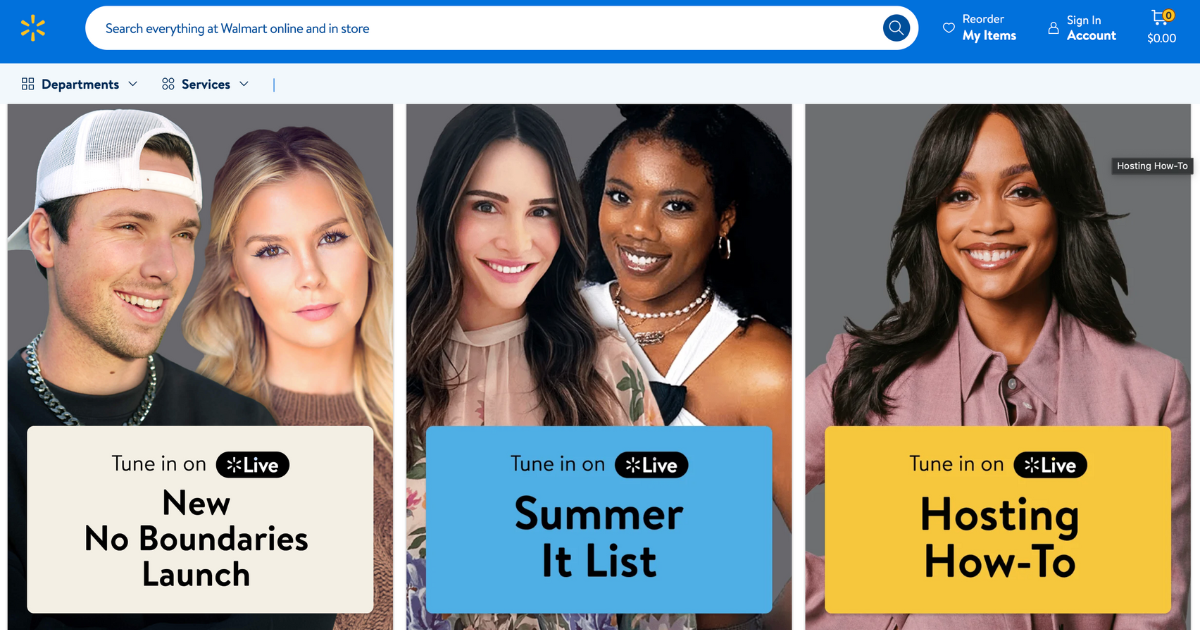
In 2022, retail giant Walmart started to bring live shopping video content directly to its website.
When shoppers head to the Walmart website, they can click on the ‘Live’ button in the top navigation bar:
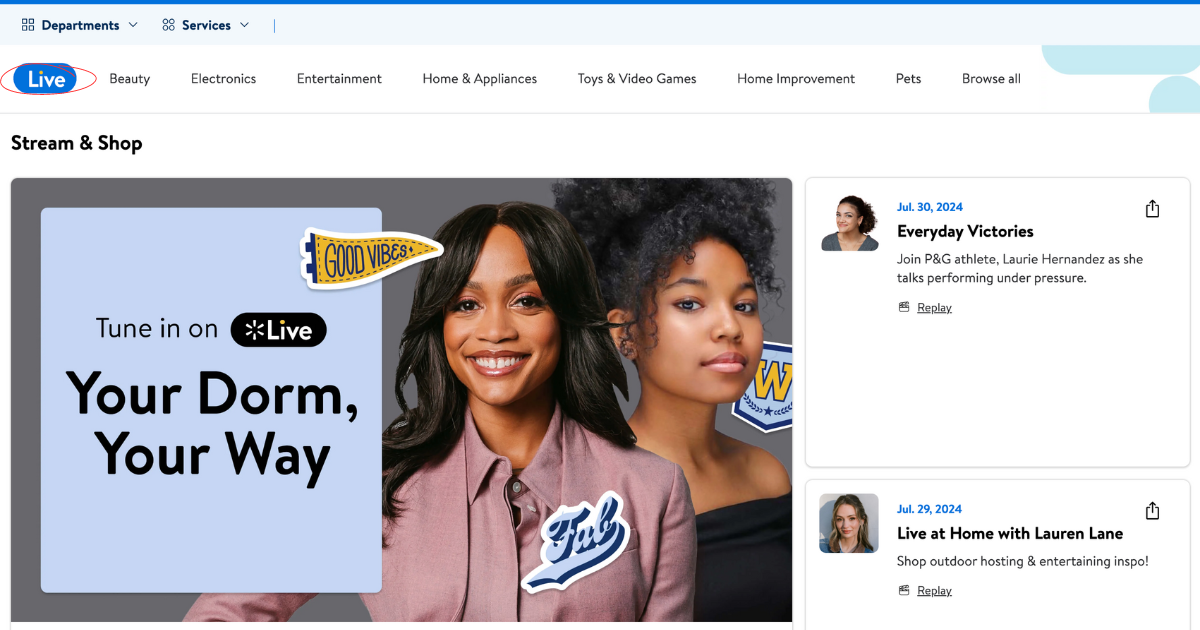
From here, viewers can see all upcoming live shopping sessions, their theme, and some information about the hosts. Walmart also allows customers to replay old live shopping videos. By keeping the entire experience on one website, Walmart gains valuable customer data and controls the whole shopping journey.
Impressively, Walmart has leveraged its industry influence to partner with brands like P&G, L’Oréal, and Unilever. The site's live shopping videos feature influencers, dermatologists, and haircare experts discussing products. When it comes to live shopping, hiring popular creators to host can bring a wealth of new viewers (and buyers) to your brand.
Pai Skincare
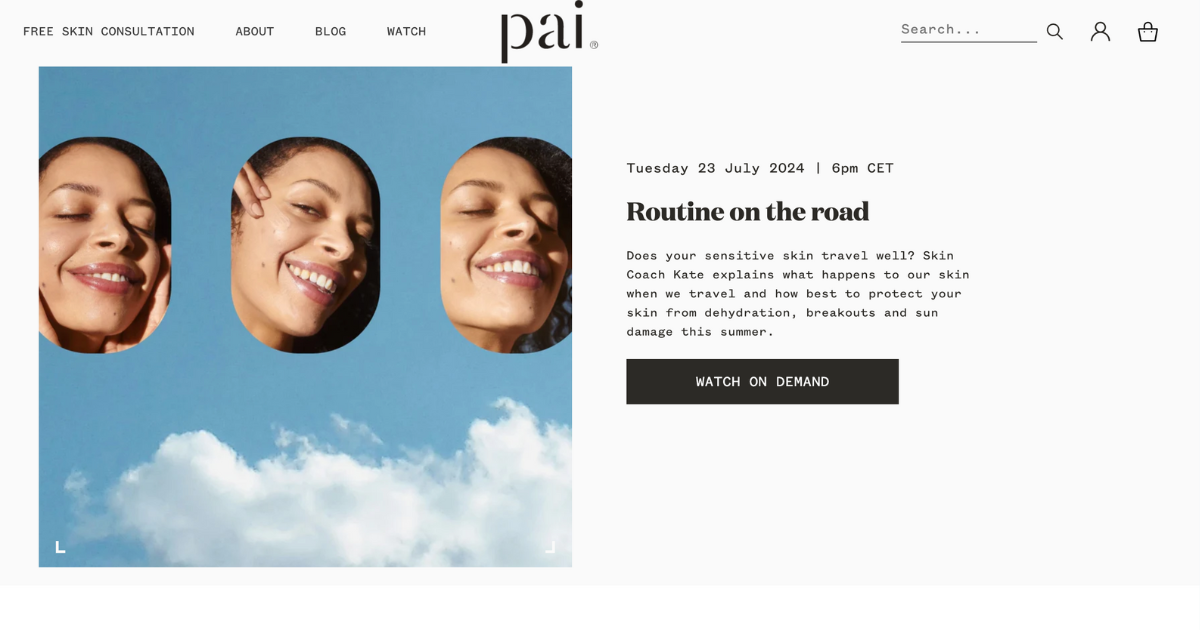
A brand targeted to those with skin sensitivities, Pai has seen massive success from its live shopping events.
Shoppers can check out upcoming livestream events on the Pai website and even watch prior event episodes on-demand.
When watching on the Pai website, shoppers can easily add products from the live stream to their shopping basket, chat with other viewers, and check out, all on the right-hand side of the screen:
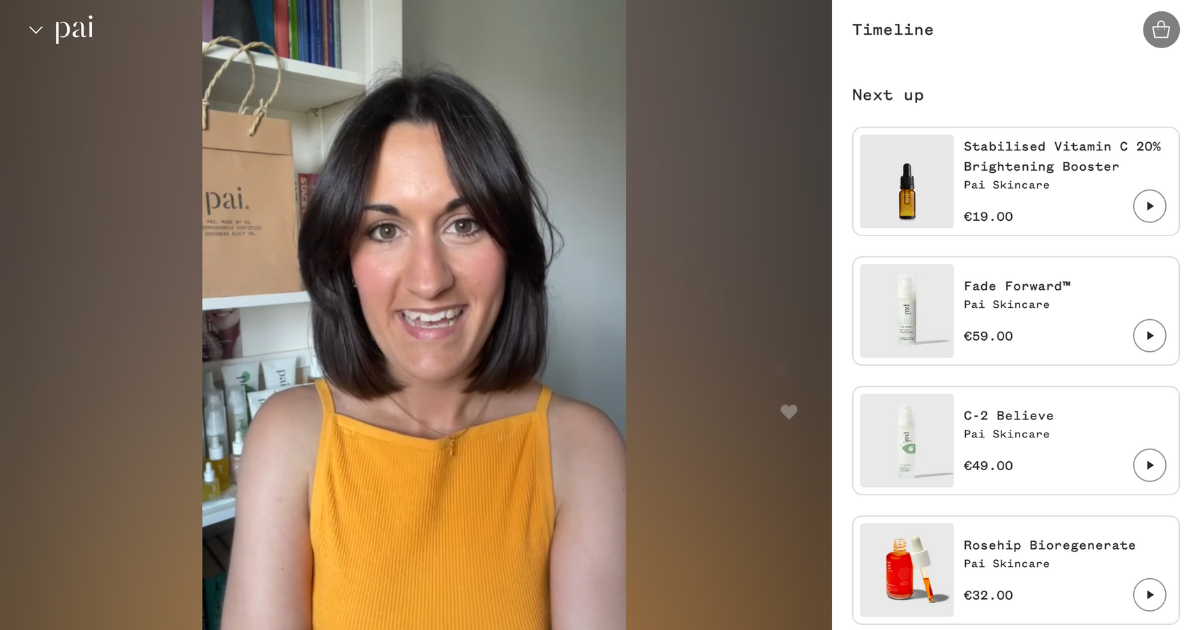
Here’s the kicker: Pai generated 10% of its total ecommerce revenue in 2021 from its live shopping feature alone, which boasted a 17% conversion rate. Pretty impressive stuff.
Similarly to Walmart, Pai will often ask well-known creators in the skincare space to host their live shopping experiences, as well as skincare professionals who work within their labs.
Nordstrom
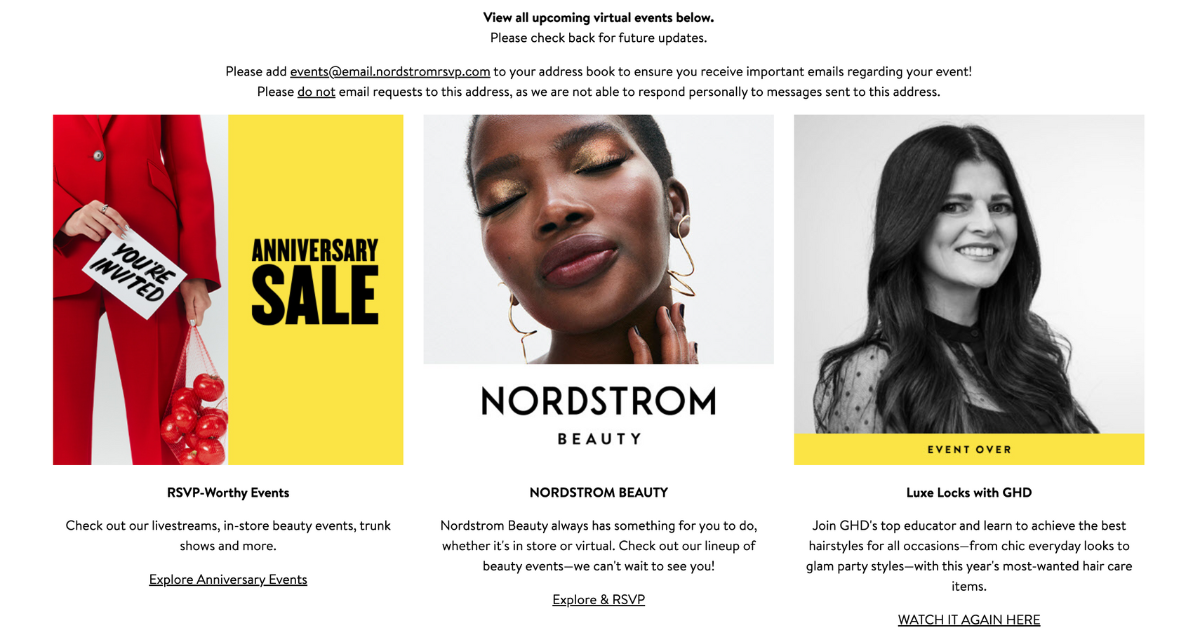
Since 2020, Nordstrom has hosted over 50 live shopping events.
The retail giant has perfected its live shopping formula, hosting events focussing on beauty, clothing, jewelry, electronics, and more. Shoppers can RSVP for upcoming events at Nordstrom Live, allowing the retailer to access valuable customer data, which can improve demographic understanding and retargeting down the line.
The company is focused on continually improving its digital shopping experience, aiming for its online marketplace to become the “Spotify of Fashion.” In 2023, digital sales represented 36% of Nordstrom’s total revenue.
What are People Buying During Livestreams?
Considering live shopping is simply an extension of ecommerce, anything you can purchase online can be bought during live shopping. According to a study by McKinsey, the top categories bought during live shopping streams are as follows:
- Beauty & Personal Care - 7.6%
- Fashion - 35.6%
- Electronics - 4.6%
- Furniture and Decor - 3.6%
- Consumables - 7.4%
While these categories have the highest live shopping viewership, plenty of brands selling products in different retail categories still have great results from live shopping. Success mainly comes down to connecting with your audience, creating engaging content, and generating excitement for your product.
Benefits of Live Shopping For Your Business
By now, it’s clear that live shopping offers ecommerce businesses a chance to increase sales and reach new buyers. But if you need further convincing, here are 5 more major benefits live shopping can provide your business, from brand awareness to sustainable growth.
Engaged Customer Base
Let's face it: we’re bombarded with advertising content daily, and our attention spans are shorter than ever. Trying to keep audiences engaged with typical ads isn’t easy, but live shopping offers a refreshing change of pace. Rather than being a passive consumer, shoppers are encouraged to actively participate throughout the entire experience.
Digital shopping events are a win-win for brands. While they’re primarily a sales funnel (and a good one), the process isn’t just about selling. It's also about creating an experience people crave. The level of engagement you generate from live shopping is unmatched by static social media ads, EDMs, and website banners.
With live shopping, every broadcast helps build your community. Humans love to feel connected, and live shopping fosters a sense of belonging, turning casual browsers into returning customers.
Stronger Brand Awareness
When it comes to selling online, saturation is heavy. Live shopping offers a way to cut through competitor noise, get more eyes on your product, and connect with your customers directly. We know video ads are 64% more likely to convert a sale than static image ads, and live shopping is even more engaging. You're not just marketing to people; you're having a real conversation, and people remember conversations.
The nature of live shopping invites audiences to actively participate. They ask questions, gather advice, and share recommendations with others, building lasting impressions rather than fleeting ones. Your viewers leave the live experience feeling closer to your brand – and more likely to recommend it to others.
You can also partner with different influencers and creators to boost brand awareness. In the best-case scenario, their followers become your followers. And at the least, you increase your brand exposure beyond your current audience.
Higher Conversion Rate
Earlier, we mentioned that Pai Skincare saw a 17% increase in conversions from live shopping alone. You might be wondering how this is possible, so we’ll explain.
First, let’s consider why shoppers resist buying online: they can’t see, touch, or try the products. While live shopping can’t physically transport shoppers to your retail store, it does a pretty good job of easing any doubts they may be having. Hosts can showcase, demonstrate, and explain products in detail, plus answer any questions shoppers have in real time.
Second, as mentioned above, partnering with influencers and creators with a loyal following can also increase conversions. These people are trusted figures, and their audience is far more likely to buy your product if they see somebody they look up to promoting it.
Lastly? Good old FOMO. Live shopping shows your customers who purchases what (and when) the entire way through the stream. Pop-ups can also let viewers know which products are on special and how many stock units are left. Hosts can offer special discount codes during streams that become void once the broadcast finishes, increasing the urge to buy now and save. Fun fact: impulse buying accounts for around 40% of ecommerce.
Lower Product Return Rate
To continue from the previous point, live shopping's ability to showcase products better than online galleries has another significant benefit: fewer returns.
According to research, this can mean a decrease in product return rate of up to 40%. Because your shoppers can see products in action, how they work, and their results, you are more likely to meet their expectations when placing their order. Live shopping can help avoid confusion or misunderstanding of what’s on sale.
Low-Cost, Long-Term Growth Channel
According to data, companies working to establish their brand with live streams could see upward of 25% growth.
Another interesting statistic is that 70% of sales from live shopping happen after the event, on replay. By building out a library, you can generate growth from your upcoming lives and your back catalog.
How to Start Selling Products with Live Shopping
If we’ve convinced you that live shopping is a no-brainer, it’s time to run through the steps. Once you’re up and running with live shopping, it’s easy to continue creating and promoting events.
1. Choose Your Products for Promotion
The first step is simply choosing which products to promote during your live. Unless your range comprises only a few items, it’s impossible to showcase everything.
You can use live shopping to promote your popular, upcoming, and unpopular products. For example, you can use streams to generate hype and showcase new products directly to your audience before anybody else by offering exclusive launch deals.
On the flip side, people may not know enough about products that aren’t selling as well as you’d hoped. By showcasing these products in a fresh light (and by a trusted host), you can help ease any confusion, worries, or doubts your customers may have.
Choose which products your live will focus on, and it’s time to schedule your event.
2. Schedule Your Live Shopping Event
Choosing a date and time really just comes down to knowing where most of your audience resides and what time they’re most active online. Don’t worry too much about your global audience, you can’t cater to everyone. Just be sure you promote the event well and provide replay access. Remember, 70% of sales from live shopping happen after the event. Ensure your customers know about the event and where to access the recording.
You can provide some kind of incentive for those who can’t make it live. For example, product discount codes that work in checkout for 7 days after the broadcast ends.
3. Outline the Event
Nobody remains in a monotonous stream. Live shopping events shouldn’t feel like a sales push but more like an exclusive get-together. A clear event format with an outlined running sheet can help avoid dead air and brain zaps.
There are really no rules on what you can and can’t do during live shopping events (beyond the general content guidelines for each hosting platform), but some formats that seem to work for brands currently are:
- How-to’s and tutorials
- Chats with an expert
- Influencer review or get-ready-with-me
- Meet our founder
- Team/staff picks
Sephora saw great results with their Facebook live events in 2022, inviting renowned dermatologists to chat skincare, makeup artists to chat cosmetics… you get the picture.
Consider the people and content topics trending among your customer base, and work them into your outline.
4. Choose Your Hosting Platform
You need a hosting platform to host your live shopping event. While larger companies can hire developers to build this into their own website, most brands use one of three hosting platforms.
You can use social media platforms with in-built live shopping capabilities (TikTok Shop and YouTube), ecommerce tools, or dedicated live shopping platforms. We’ll discuss the pros and cons in more detail later.
5. Promote Your Live Shopping Event
Promotion of your event is everything, so go all out. Use EDMs, social media stories, static posts, sponsored ads, automated DMs – you name it! The idea is to generate as much excitement as possible before the event so as many people register as possible. Even if they don’t make it, taking registrations for live events also builds your customer list for retargeting later on.
In your promotional material, highlight any discounts, offers, or exclusives you may be offering. If your host is somebody exclusive, make sure to leverage that, too.
6. Do a Tech Check, Get Ready, and Go Live
It’s time to go live! Well, almost. One final thing: a tech check.
The last thing you want is your server dropping out, your sound missing, or any other technological mishaps to arise. Not the best look for your brand.
To avoid any of the above happening, do a solid tech check first. Test out your lighting, microphone, camera, and the hosting platform you’ll be using. If necessary, make a dummy account and run yourself through the process from start to finish. Once you’re comfortable with the technology and the go-live process, it’s showtime.
The Best Live Shopping Platforms
As mentioned earlier, most live shopping events are hosted using one of three methods. Below, we’ll briefly discuss each method and its pros and cons.
Social Media
To keep up with growing trends and capitalize on commissions, some social media platforms offer native live shopping features (besides Meta, which discontinued its live shopping features in 2023). Let’s take a look at the most popular:
YouTube
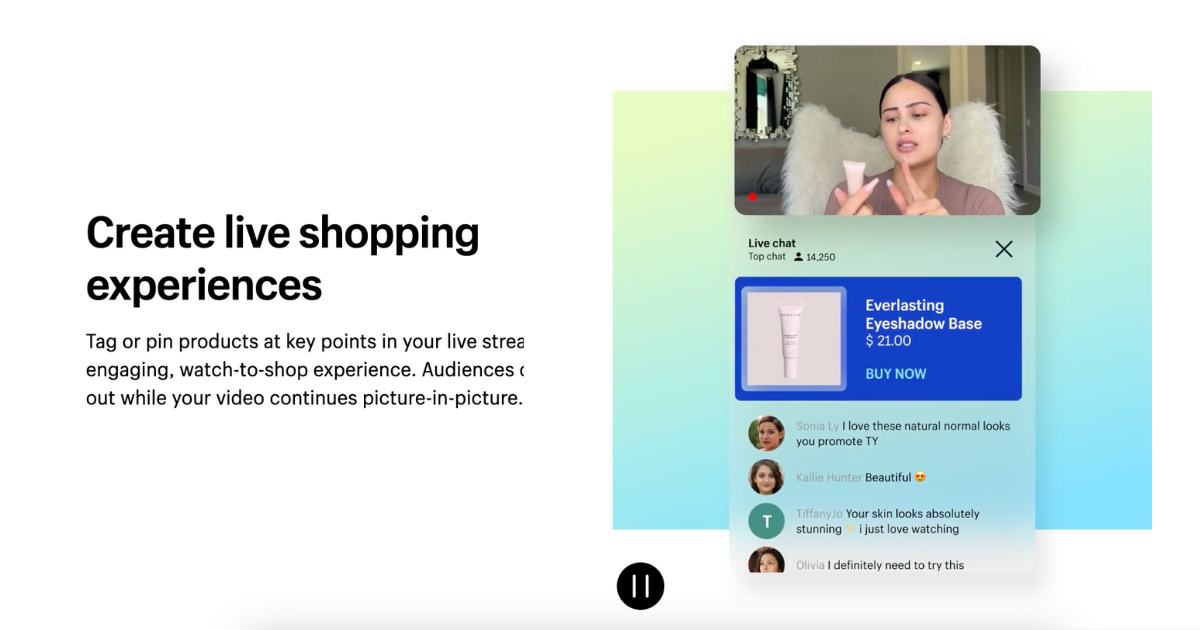
YouTube has partnered with Shopify, making it simple for merchants using it as their online marketplace to start broadcasting live shopping videos through YouTube.
The integration allows sellers to Instantly sync products to YouTube. The feature also ensures that product names, images, pricing, and inventory details are always up-to-date, automatically syncing from your Shopify store to your YouTube channel. While streaming, your channel can pin products at key points, creating a watch-to-shop experience. Viewers can complete purchases while your video continues picture-in-picture.
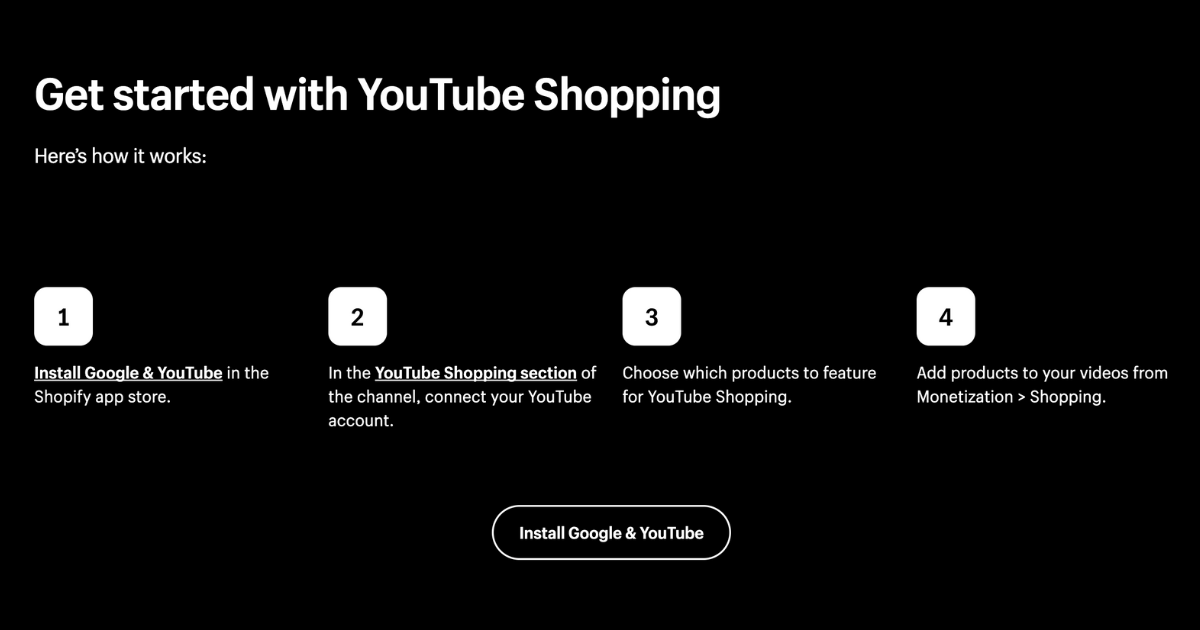
Not only does YouTube offer you access to a vast potential audience, but the platform finds that channels featuring a weekly livestream grow their subscribers by up to 40%, with viewers spending 70% more time watching their live content.
TikTok Shop
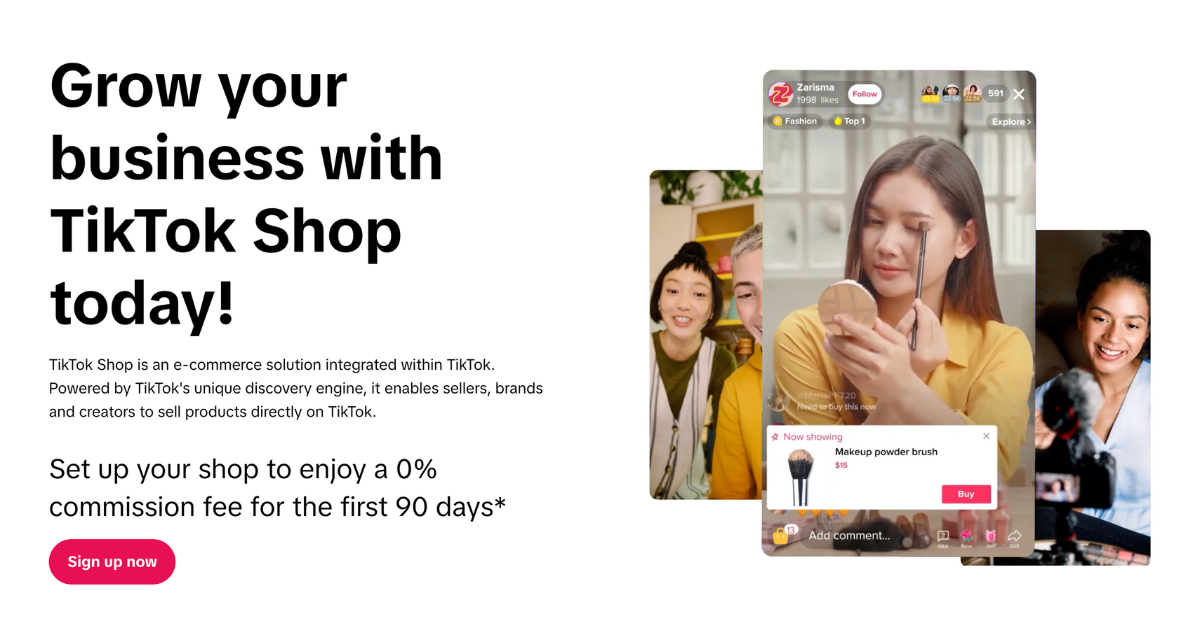
TikTok’s in-app shopping function, TikTok Shop, allows sellers, creators, and affiliates to link your TikTok account to a storefront and access features like ads, live shopping, a product showcase, and a shopping tab.
This year, 33.3 million US-based social buyers and $20 billion in merchandise sales are projected through TikTok Shop, making it a promising platform for sellers who want to incorporate live shopping into their strategy. While you can only sell physical products through TikTok Shop, you can sell digital products with the help of TikTok and an external platform, like Whop.
To use TikTok Shop, you must reside in Indonesia, Malaysia, the Philippines, Singapore, Thailand, the United Kingdom, the United States, or Vietnam.
Shopping Tools for Ecommerce Brands
While some social media platforms offer live shopping solutions, they may be too limited to meet your needs. Enter specialized live shopping tools, built to connect with your existing online store and enable you to host engaging live shopping sessions. While countless options exist, the following platforms are some of the most popular, offering a range of capabilities for sellers.
Bambuser
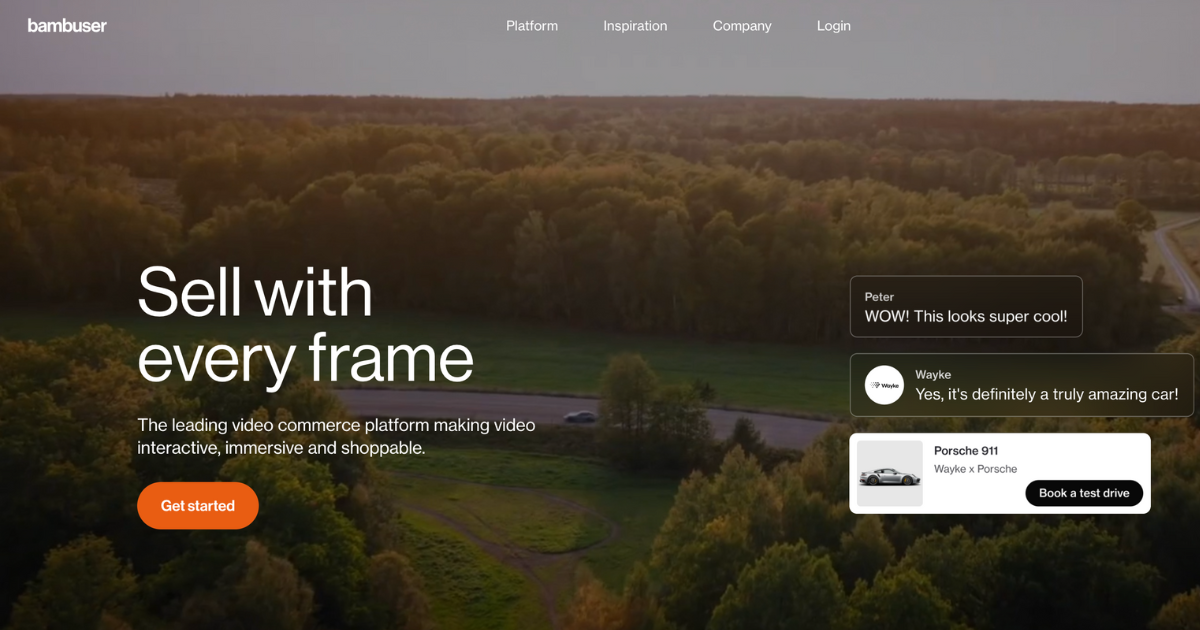
Bambuser is one of the more versatile solutions for live shopping. Hosts can even transform existing social media videos into ‘shoppable’ experiences, which is particularly handy if you’ve previously worked with an influencer and had good engagement. Remember what we said about replays? The platform supports large-scale and small businesses and boasts a clientele including Bloomingdale's and Pai Skincare.
Pros: Allows sellers to transform existing videos into shoppable content, caters to businesses of all sizes, and offers interactive elements like live chat and polls.
Cons: Due to its versatility, Bambuser might have a steeper learning curve than more specialized platforms, and pricing can be a factor for smaller businesses.
Sprii
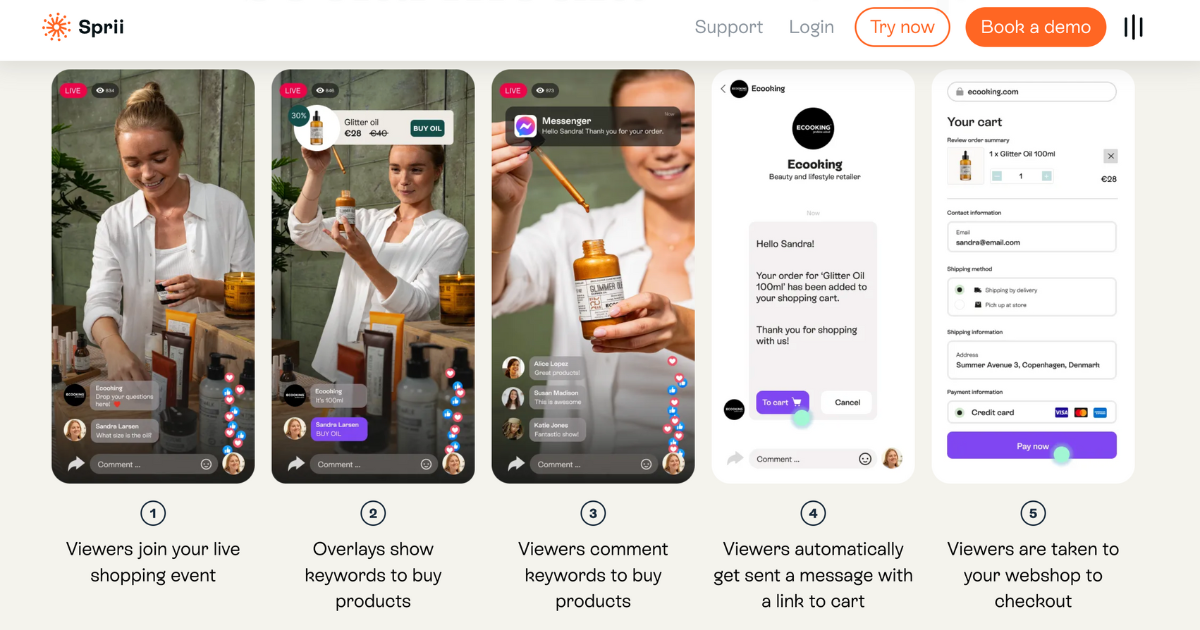
Sprii is an up-and-coming entrant to the live shopping scene. It focuses on providing a platform for influencer-driven live shopping experiences. With a strong emphasis on the creator economy and engagement, Sprii helps connect brands with influential creators to drive sales.
Pros: Like Bambuser, Sprii lets you broadcast live shopping events across various platforms. Plus, its focus on influencer marketing offers a unique solution for sellers looking to grow their online presence.
Cons: The platform might have less robust features and functionalities as a newer solution than other more established competitors. Pricing may also be a stretch for sellers with less marketing spend available.
Livescale
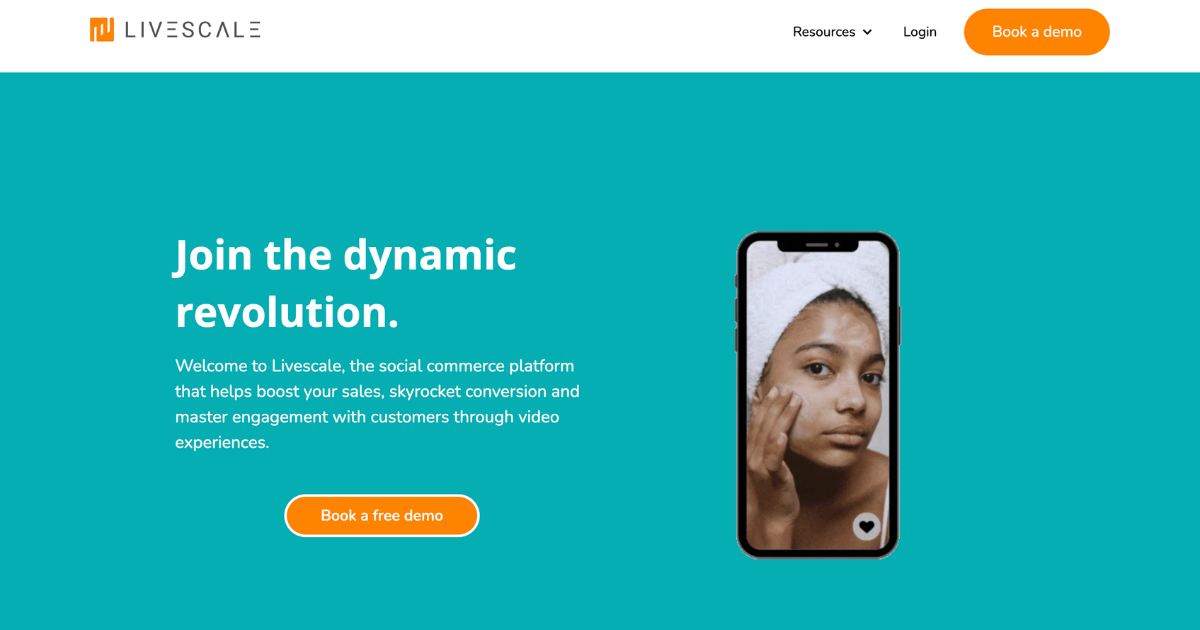
Livescale works with renowned brands like Kiehl's and Giorgio Armani. The platform offers features to help sellers promote upcoming events, driving anticipation and engagement. Sellers can use Livescale to host live shopping events on their own website and social media platforms.
Pros: Included promotional features help sellers drive audience interest and viewership. Plus, the platform caters to high-end brands, so you know it’s credible.
Cons: Given the focus on premium brands, Livescale's pricing might be higher than other options. There is also a strong focus on beauty and cosmetic brands, which may not work for your product.
Live Shopping Platforms
While the above tools offer impressive integrations, they can be costly and inaccessible to smaller businesses. In contrast, live shopping platforms allow anyone from side hustlers to big-name brands to set up shop. Unlike tools that focus on technical integrations and still rely on your ability to promote, these platforms are designed for discovery.
Shoppers can browse a variety of live streams, finding your products without the sole effort of your marketing.
Amazon Live
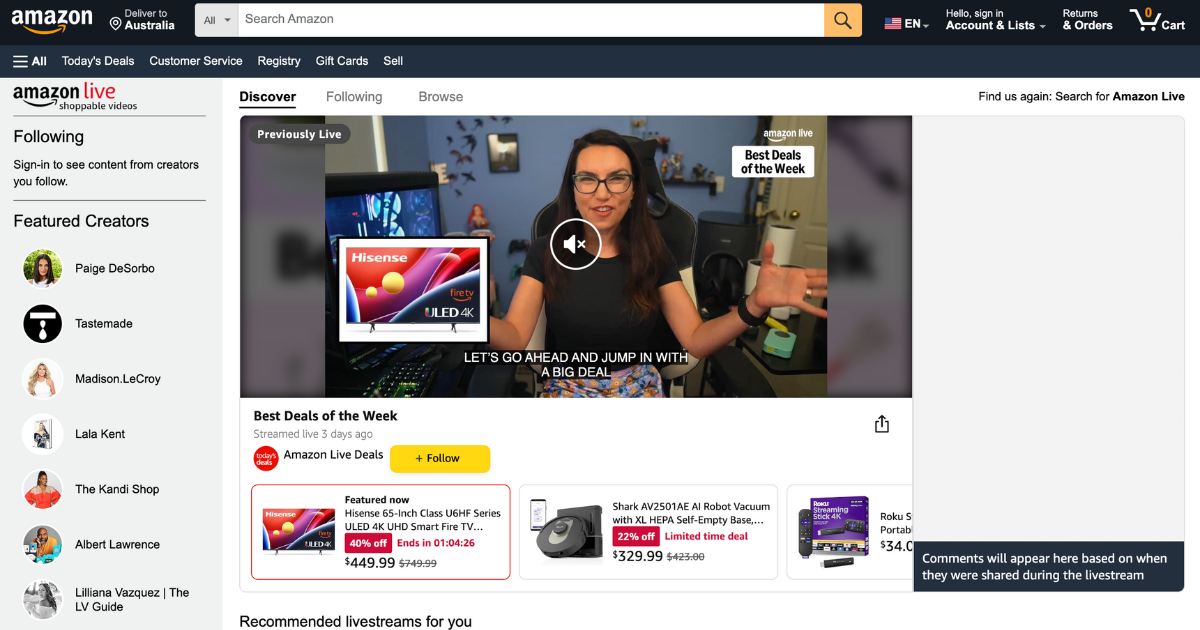
Amazon Live is a leading example. Being a platform from the world's largest online retailer, it offers a built-in audience and easy integration with product listings.
Pros: Amazon's customer base can significantly boost visibility, and the platform aligns with existing Amazon product listings for a cohesive shopping experience.
Cons: Amazon’s global popularity can lead to intense competition for viewer attention, meaning you could get overshadowed. Also, as an Amazon platform, you're subject to their rules and regulations.
ShopShops
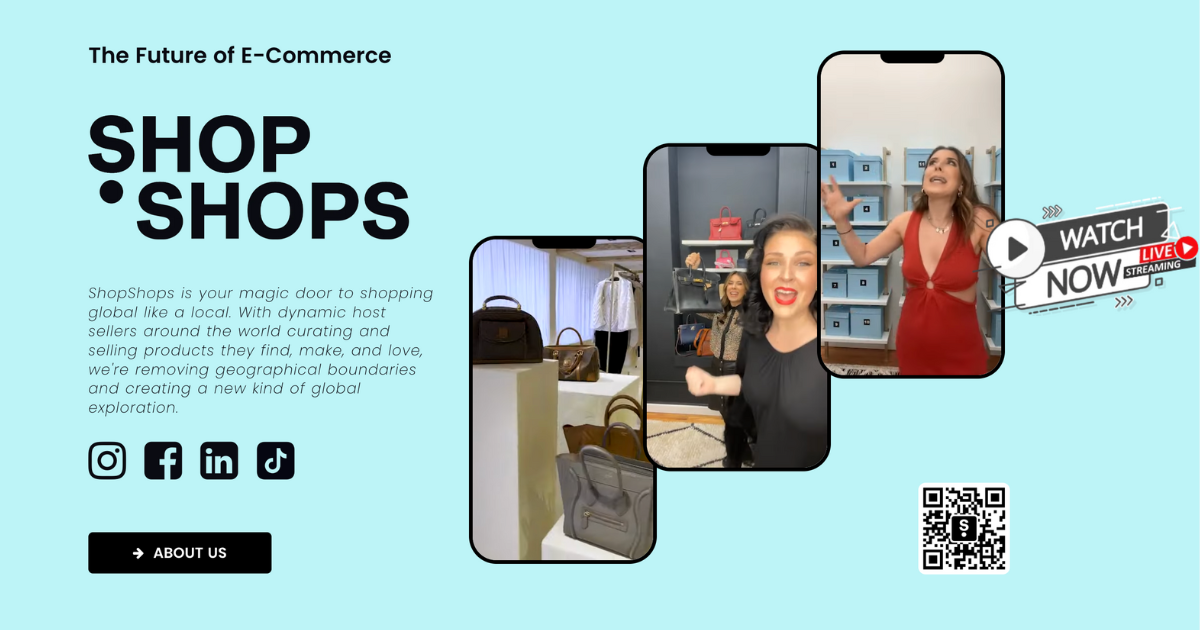
ShopShops caters to fashion, beauty, and lifestyle brands. It offers a visually driven platform with short, vertical videos that are key to capturing online attention spans.
Pros: ShopShops optimizes content for mobile consumption, catering to a younger audience. It has a dedicated following of beauty, lifestyle, and apparel consumers.
Cons: A niche focus on fashion, beauty, and lifestyle may not suit all brands. As a newer platform, it has a smaller user base and might have fewer features and functionalities.
NTWRK
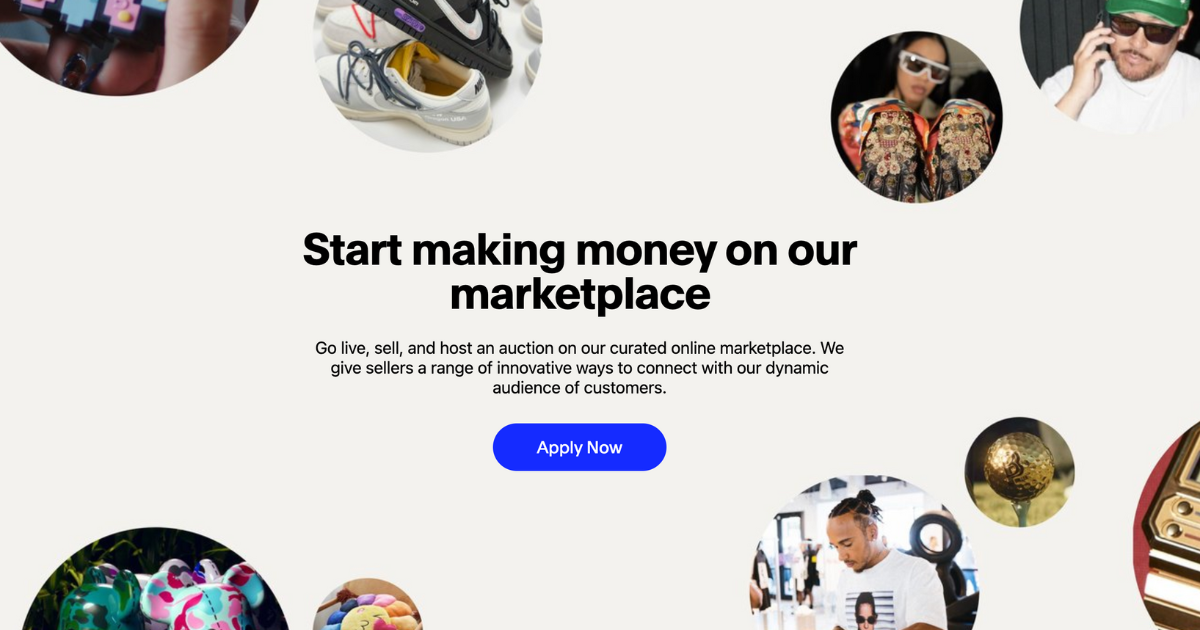
NTWRK cleverly chose a niche with a Gen Z and millennial customer focus, and the platform is visually appealing and easy to navigate. Sellers can promote items that fall within NTWRK’s designated categories, which include sneaker resale, toys and collectibles, apparel, art, and music merch.
Pros: With a Gen-Z and millennial focus, the platform appeals to the most active demographic for online shopping. Plus, they offer a more comprehensive range of accepted products than some competitors, including hobbyists and side hustlers.
Cons: While a niche audience may work for some, for others, focusing on a specific demographic might limit your reach. As the platform grows, it can lead to increased competition.
As you can see, these platforms and tools all have their own strengths and weaknesses regarding integrations, capabilities, and guidelines. So think of what matters most to your brand – reach? Accessibility? The ability to promote? Think about where your audience is more likely to be. Is it on social media or an online marketplace?
7 Tips For Your Live Shopping Broadcast
While we’ve given you a thorough overview of how to get started with live shopping, you may still feel apprehensive. Once you’ve chosen your platform and planned your content, follow these tips to make the most of your first (and second, and third) broadcasts. Remember, everything is practice, so don’t be afraid to make mistakes and learn along the way.
1. Understand Your Audience
You can’t connect with your audience if you don’t understand them. This goes for everything, including sales, marketing, community engagement, and, as an extension, live shopping experiences. We’ve all feared planning a party where nobody shows up, right? When scheduling your live broadcasts, you can avoid feeling that by ensuring you understand your audience and plan accordingly.
If you haven’t already, start creating an audience persona (or a few). Who is buying from you? How old are they? Where do they live? What do they do for work? Which influencers do they follow? You can use the answers to determine when they’ll likely be online, which products they’re looking for, and which pain points or trends are popular. When you focus your live shopping experiences directly to your audience personas, you’ll see an increase in engagement.
To help you start gathering information about your customer base, look into free online tools like Google Analytics.
2. Build an Engaged and Loyal Following
Understanding your audience is the first step in turning viewers into loyal fans. But building a loyal following is like anything good: it takes time and care.
So how do you begin? With regularity. Showing up consistently breeds trust and creates anticipation with audiences. Start to build credibility by establishing a consistent live shopping schedule. Use your current social media platforms to promote and encourage viewers to join with incentives.
Beyond just selling products, focus on building up relationships. Share stories, behind-the-scenes bits, and personality. Let your audience get to know you and your brand on a deeper level. People buy from people they like. Inviting influencers and popular creators to join your broadcasts can really drive trust with your audience.
Remember, audiences crave interaction. Respond to comments, questions, and requests in real-time. Make your viewers feel heard and valued instead of being pitched to.
3. Keep it Exciting
Live shopping is all about energy and engagement. Boring broadcasts lead nowhere and could even damage your brand reputation.
Most live shopping platforms and tools offer interactive features like polls, stickers, and other on-screen elements to keep things engaging. Try to get familiar with these before your first broadcast.
As we mentioned earlier, a loose script is your friend, keeping you on track without sounding stressed or stuttering. As for episode formats, you can afford to get creative and experiment. The more audience involvement, the better. We’re about to dive into some popular formats, but the most important thing is to focus on having fun and allowing your brand’s personality to shine.
4. Connect with Your Customers Using Q and A’s
People don’t know what they don’t know – so educate them. Q&A sessions are hugely successful in fostering brand trust and reliability. Earlier, we discussed how live shopping can lower your product return rate, and Q&As are the perfect way to educate your audience on precisely what they’re buying, how to use it, and more.
You can run a questionnaire on social media, your website, or via email before the live event to get an idea of your audience’s most popular questions. Or, you can just go live and wing it on the broadcast.
5. Feature Product Tutorials
Certain products just need to be seen in action, which can be hard online. Think clothing, cosmetics, accessories, and appliances. Featuring tutorials on your products can help convert customers, often driving the desire to purchase.
While you may already feature product tutorials on social media, live tutorials hit differently. Why? Customers know there’s no room in real-time to manipulate or falsify results. You can easily pair product tutorials and demonstrations with other episode formats, such as Q&As or sneak peeks.
6. Give Sneak Peeks of Upcoming Products
Speaking of, who doesn’t love an exclusive first glance? Promoting products and generating hype around upcoming releases is key for any brand, and sneak peeks are the perfect way.
This is the perfect opportunity to reward dedicated customers who tune in to sneak peek live streams a chance to pre-order with a discount code or freebie included in their order. Giving back builds a generous brand image with your customers and creates a sense of loyalty.
7. Consider Working with Popular Creators and Influencers
Working with popular creators, influencers, and experts is a tried-and-true method of boosting your broadcasts. As we said, people buy from people they like. Figure out who your audience likes, and reach out to those creators with an offer or incentive to join your event. While influencer marketing might feel out of reach for smaller brands, that doesn’t have to be the case.
Influencers can be divided into four categories: mega, macro, micro, and nano. Nano influencers have 1000 to 10,000 followers. While these creators may not have as big an audience, their followers closely connect with them because they are highly engaging with their audience.
Getting in touch with nano influencers is typically very easy as they run their own account and love to hear from brands interested in partnering with them.
Why Live Shopping Works: Community and Connection
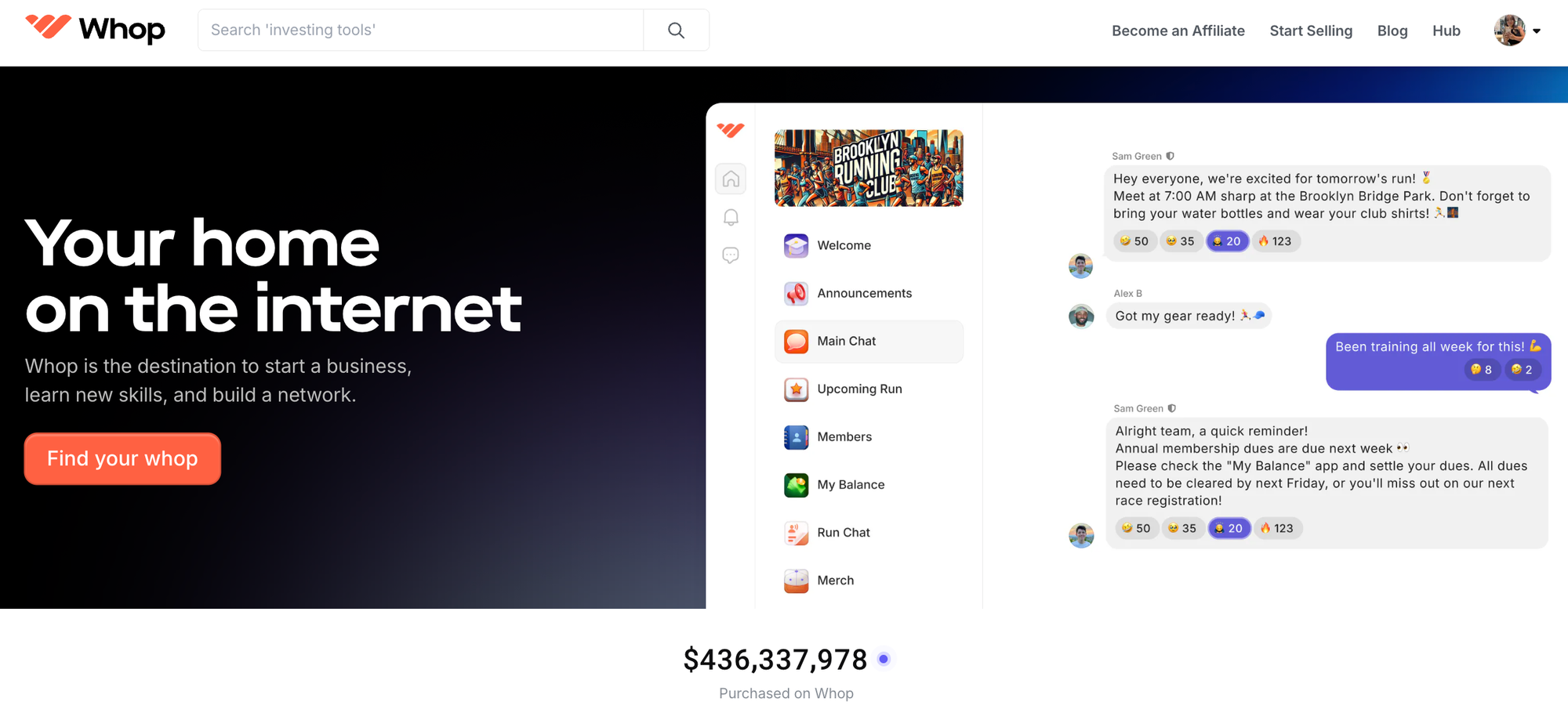
Live shopping is undoubtedly a solution for brands looking to connect with their audience more deeply. It doesn't just drive product sales, it actually fosters higher engagement and awareness.
Why? The answer is simple. Customers are eager for connection, and connection builds community.
However, live shopping might not be for everyone. It requires an investment that some business owners and small brands might not be comfortable with, and it comes with its own unique set of challenges that need time to overcome. Thankfully, there are other options, too.
Building a private community can also deepen connections and grow your loyal customers.
If you’re not ready to dive into live shopping, Whop allows sellers to build private fan communities where you can still host live videos, answer Q&As, demonstrate products, and more. You can even offer different access tiers within your community, such as a free tier with basic access and a paid tier with exclusive content.
Plus, we keep things simple with a transparent 3% fee so that you can keep 97% of your income.
FAQs
What is TikTok Live Shopping?
TikTok Live Shopping was created to blend entertainment and e-commerce. Sellers can use TikTok Shop to showcase products through live videos with built-in features like live chat, stickers, and Q&A sessions.
Customers can purchase any products the seller has listed in their TikTok Shop storefront and promote within the live broadcast, checking out without leaving the video stream.
What is Amazon Live Shopping?
Amazon Live Shopping brings the familiar shopping experience to a live video format. Brands and influencers can showcase products directly to Amazon's vast customer base. The platform seamlessly integrates with Amazon's product listings and checkout process, providing a smooth shopping journey.
However, hosts must sell already with Amazon and can only feature this storefront during broadcasts. You can leverage Amazon's trust and brand recognition but may experience steep competition.
What is Facebook Live Shopping?
While Meta no longer offers a dedicated live shopping feature, Facebook and Instagram are still valuable e-commerce tools for businesses. Live videos on Facebook can still be used to chat with audiences, showcase product demonstrations, and facilitate Q&A sessions.
However, direct product sales through the platform are currently impossible without integrating an external ecommerce solution, such as the tools we discussed earlier.
